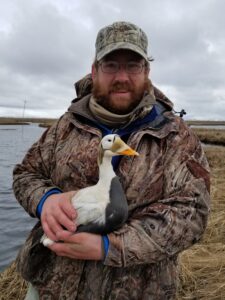Director, Arctic Program, Loon Program

Micah Miller, Wildlife Research Scientist and director of the Arctic Program.
Micah Miller, Ph.D.
Director, Arctic Program, Loon Program
micah.miller@briwildlife.org
Micah is a broadly-skilled avian ecologist with specialty in waterbirds and environmental toxicology. He joined BRI in 2023 after working with the U.S. Fish and Wildlife Service in Alaska for many years, and graduate studies at Southern Illinois University. His background includes a wide range of projects on waterfowl, upland birds, and seabirds, especially for nesting ecology, contaminants, and endangered species conservation. Micah’s graduate work focused on contaminant and habitat issues for sea ducks breeding along the Arctic coast of Alaska, using a wide range of datasets and research approaches. He is now focusing on conservation of loons and Arctic birds, as well as legacy and emerging contaminants impacting North American bird populations.
Education & Certifications
Education
-
Southern Illinois University – Ph.D., Zoology with specialization in Ecology
-
Southern Illinois University – M.S., Zoology
-
University of Alaska Fairbanks – B.S., General Studies
U.S. government trainings:
- Bear safety training (DOI)
- Firearms safety training (DOI)
- ATV/UTV training (DOI)
- B3 aircraft safety training, including A-312 water ditching and survival course (DOI)
- Motorboat operator certification course (MOCC; DOI)
- Oil spill response training (DOI)
- Unexploded ordinance (DOD)
- Driver safety (DOD; USDA)
Other training:
- 40-hr HAZWOPER
- First Aid, CPR, and AED training
Research Interests
Research interests:
- Breeding biology
- Migratory ecology
- Waterfowl and seabird conservation
- Arctic bird ecology
- Wildlife toxicology
Expertise:
- Capture of waterbirds with a wide range of approaches
- Sampling of blood, feathers, and other tissues
- Environmental contaminants
- Stable isotope ecology
- Habitat modeling
Journal Articles
Miller, M. W. C., J. R. Lovvorn, N. R. Graff, N. C. Stellrecht, and S. P. Plesh (2023) Prey availability and foraging activity by tundra-nesting sea ducks: Strong preference for specific wetland types. Ecology and Evolution 13(9): e10375. https://doi.org/10.1002/ece3.10375.
Plesh, S. P., J. R. Lovvorn, and M. W. C. Miller (2023) Organic matter sources and flows in tundra pond food webs. PlosONE 18(5): e0286368. https://doi.org/10.1371/journal.pone.0286368.
Miller, M. W. C., J. R. Lovvorn, N. R. Graff, and N. C. Stellrecht (2022) Use of marine vs. freshwater proteins for egg-laying and incubation by sea ducks breeding in Arctic tundra. Ecosphere 10.1002/ecs2.4138.
Miller, M. W. C., J. R. Lovvorn, A. C. Matz, R. J. Taylor, M. L. Brooks, C. J. Latty, and T. Hollmén (2019) Interspecific patterns of trace elements in sea ducks: Can surrogate species be used in contaminants monitoring? Ecological Indicators 98: 830-839.
Miller, M. W. C., J. R. Lovvorn, A. C. Matz, R. J. Taylor, C. J. Latty, and D. E. Safine (2016) Trace elements in sea ducks of the Alaskan Arctic coast: Patterns of variation among species, sexes, and ages. Archives of Environmental Contamination and Toxicology 71: 297-312.
Lovvorn, J. R., M. F. Raisbeck, L. W. Cooper, G. A. Cutter, M. W. Miller, M. L. Brooks, J.M. Grebmeier, A.C. Matz, and C. M. Schaefer (2013) Wintering eiders acquire exceptional Se and Cd burdens in the Bering Sea: physiological and oceanographic factors. Marine Ecology Progress Series 489: 245-261.
Research Reports
Miller, M, L. Savoy, M. Chickering, and C. Persico. Long-term monitoring of mercury in fish tissue at Moore and Comerford Development Reservoirs: 2023. Report BRI 2024-07


